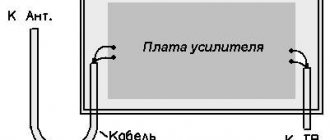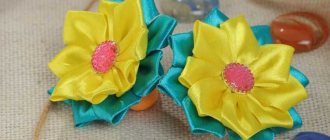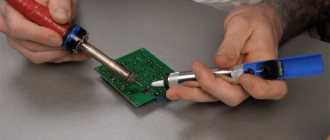The flux ensures stable arc burning, promotes the formation of a reliable welded joint, removes unnecessary impurities from the welding zone and generally improves the quality of work. Flux can be bought in the store; modern manufacturers offer a large assortment. But we suggest you make the flux yourself. It won't take much time, but it will save you money.
Mainly, soldering flux is used for welding wires and small parts. There is also a special flux for bga soldering. In this article we will share a "recipe" for making different types of flux or, more simply put, solder, which can be used in most small soldering jobs.
Chemical composition of the alloy for joining materials
Pure silver is a soft metal and is therefore not suitable for work.
Mostly, craftsmen use mixtures that contain zinc, nickel, aluminum, copper, and cadmium. In addition to silver, silver solders also contain zinc and copper. A seam made with this composition is strong and durable. Compounds of silver, copper, zinc have a high melting ability. They are used for silver solder. To control its percentage composition, GOST 19746 74 was developed. Solders, silver grades, are always indicated in the instructions for the products. The soldering seam obtained in this way is durable.
Modern soldering processes involve the use of silver solder, which, when connecting nodes, is suitable for step soldering. Such work requires the use of an alloy that can withstand temperatures of 600°C.
The solder contains ingredients such as 30% silver, 20% copper, 16% zinc, 33% cadmium. The alloy is very brittle and is intended for soldering materials that are not subject to vibration. The composition with the amount of silver increased to 52% is very fluid, but withstands loads well during multi-stage stages of soldering materials.
Silver solder has high strength, is resistant to corrosion in aggressive environments, has a low melting point, and high thermal conductivity. During operation, it completely fills the gap between the parts being soldered and fits well on the metal surface.
When working, you need to make sure that the solder completely fills the gap between the parts.
An alloy of 28.5% copper of the PSr-72 grade has high ductility. When working on creating solder with your own hands, you should remember that its melting point with copper decreases when alloyed with lithium. The resulting alloy is used for soldering steel materials that are resistant to corrosion. To reduce the melting temperature of the solder, tin is added to it in an amount of 35 to 70%. The resulting alloy allows you to solder various materials, avoiding the formation of cracks.
Preparation for soldering copper with aluminum, brass, stainless steel, iron
The preparatory period, which includes the acquisition of the necessary devices, materials, personal protective equipment, and the soldering procedure itself.
There are two ways to solder copper to copper: high and low temperature. The first involves heating the metal to 900°C, and is used for pipelines with high pressure or temperature load. For high-temperature soldering, materials intended for this are used: hard solder in the form of rods (the melting point of such solder is about 900°C) and hard-melting flux.
In order to solder copper using the low-temperature method, it is sufficient to heat the metal to 600°C (usually 300–380°C), which is achievable in domestic conditions. For the procedure, soft solder is used for soldering copper and brass in the form of a wire or rod with a cross-section of up to 3 mm and a more fusible flux. Solder is an alloy of tin, which is more than 97%, with other metals: copper, selenium, silver, antimony.
Why do you need flux? Correctly soldering copper pipes can only be done with flux - a special paste-like composition (with zinc chloride), which is applied to the surface of the connected sections of the pipe in a wide strip. It performs several functions:
- prevents the process of metal oxidation by removing oxygen;
- improves the adhesion of solder to copper;
- is an indicator of sufficient heating of the metal, signals when to apply solder and solder the copper;
- promotes uniform spreading of solder along the joint.
Safety precautions. Despite the simplicity of the process, soldering copper pipes must comply with safety rules. The danger of burns is posed not only by the burner flame itself, but also by the heated metal. Copper conducts heat well, so during operation, not only the area on which solder is placed and welding is carried out, but also the entire pipe becomes very hot, and it cools down slowly. If you need to solder copper tubing that is not already built into the piping system, preparation involves placing it on non-flammable supports where it can take a long time to cool. Before touching the welded metal from its place, you should wait until it cools completely.
The immediate danger is the open flame of the burner, so you need to purchase a tool that is convenient to work with: preferably with a movable nozzle on a long hose
Chemical composition of the alloy for joining materials
The process technology is based on the use of silver solder intended for step soldering. Considering that the solder must withstand temperatures up to 600 °C, its components are: 33% cadmium, 30% silver, 16% zinc, 20% copper. The composition is quite fragile and cannot withstand vibrations. By increasing the amount of silver to 52%, a fluid mixture is obtained that can withstand multi-stage soldering.
The creation of homemade solder is mainly for the private sector. Do-it-yourself silver solder is often made in order to carry out step soldering, when it is necessary to solder several layers of metal, since it is necessary to obtain a layer of great thickness, which cannot be created at one time.
To create such a material, you need to take 30% silver. Additional elements will be cadmium, which should be 33%, zinc - 16%, and copper - 20%. It is advisable not to use this alloy in places that are subject to strong vibrations and shocks, as it is brittle and can be destroyed under mechanical stress.
Silver solder
What happened?
The main task was:
A. it just had to work;
b. it was necessary to identify all the pitfalls of the artisanal soldering technology.
Actually, there is no particular point in driving a 35-watt processor in various tests (on my motherboard its multiplier is blocked), although even in the simplest tests that I conducted for myself before and after, I did not notice any particular difference, literally a degree or two , although all this could have been the result of a coincidence.
I note that if my sample previously worked smoothly with RAM at a frequency of 3533 MHz, then after this procedure it lost the ability to operate stable while maintaining previously existing parameters, and I had to roll back to 3466 MHz. This is also a reason to be wary and rethink everything thoroughly.
An ancient recipe for cooking silver solder
Let's try to figure out how to make silver solder at home. There are several options for its manufacture, each with its own nuances. To obtain the alloy, you will need a coin (fifty kopecks) from 1924, as well as five kopecks from 1962. For work you need: ingus, silver, gas burner, spoon.
Making silver solder begins with melting the precious metal. Then a five-kopeck coin is added. To ensure complete mixing, roll the mixture onto a spoon. The final result of mixing depends on the duration of this process. The disadvantage of this technology is the burnout of the chemical components needed for solder.
It is most convenient to heat solder on a gas burner.
- silver;
- spoon (not tablespoon);
- ingus;
- gas-burner.
At the beginning of the work, silver is melted in a spoon. Add a five-kopeck coin to the resulting melt and roll the mixture over a spoon for better mixing. The longer the spoon is rolled, the better the mixing process occurs. But there is one significant drawback: many components necessary for solder burn out.
Then the master who makes the alloy with his own hands pours it into ingus and rolls it out without annealing. The resulting solder is of high quality: 10 g refers to the 900th sample.
When soldering, it is very important to prepare fresh flux, which will ensure high-quality work. It is necessary to carefully monitor the size of the flame in the burner: a soft, not very hot fire in the form of a broom will ensure a high-quality seam.
For work, hard solders are used, which contain: 80 Ag, 16 Cu, 4 Zn, 75 Ag, 22 Cu, 3 Zn. Soft solders include: 65 Ag, 20 Cu, 15 Zn.
To obtain light silver solder used in repairing products, you need to prepare: 7 parts silver, 2.8 parts brass, 0.35 parts zinc. It is important to clean the brass from the oxide film before starting work. To obtain 10 g of solder, 999 silver is melted. After obtaining the liquid composition, add brass and mix the contents in a spoon.
- sandpaper;
- spoon;
- gas burner;
- mixing spatula;
- folds;
- scissors;
- scales.
Pure silver is not used for solder, as it is too expensive a metal.
- silver;
- brass;
- pure zinc;
- borax, which is added to the molten composition.
Sometimes pure zinc is not added: it is better to use its alloy with brass or copper. Zinc is added to the solder, wrapped in silver foil.
Preparation for soldering copper with aluminum, brass, stainless steel, iron
The preparatory period, which includes the acquisition of the necessary devices, materials, personal protective equipment, and the soldering procedure itself.
There are two ways to solder copper to copper: high and low temperature. The first involves heating the metal to 900°C, and is used for pipelines with high pressure or temperature load. For high-temperature soldering, materials intended for this are used: hard solder in the form of rods (the melting point of such solder is about 900°C) and hard-melting flux.
In order to solder copper using the low-temperature method, it is sufficient to heat the metal to 600°C (usually 300–380°C), which is achievable in domestic conditions. For the procedure, soft solder is used for soldering copper and brass in the form of a wire or rod with a cross-section of up to 3 mm and a more fusible flux. Solder is an alloy of tin, which is more than 97%, with other metals: copper, selenium, silver, antimony.
Why do you need flux? Correctly soldering copper pipes can only be done with flux - a special paste-like composition (with zinc chloride), which is applied to the surface of the connected sections of the pipe in a wide strip. It performs several functions:
- prevents the process of metal oxidation by removing oxygen;
- improves the adhesion of solder to copper;
- is an indicator of sufficient heating of the metal, signals when to apply solder and solder the copper;
- promotes uniform spreading of solder along the joint.
Safety precautions. Despite the simplicity of the process, soldering copper pipes must comply with safety rules. The danger of burns is posed not only by the burner flame itself, but also by the heated metal. Copper conducts heat well, so during operation, not only the area on which solder is placed and welding is carried out, but also the entire pipe becomes very hot, and it cools down slowly. If you need to solder copper tubing that is not already built into the piping system, preparation involves placing it on non-flammable supports where it can take a long time to cool. Before touching the welded metal from its place, you should wait until it cools completely.
The immediate danger is the open flame of the burner, so you need to purchase a tool that is convenient to work with: preferably with a movable nozzle on a long hose
Engineering works
For technical work, silver solders are used containing up to 80 parts of silver, 16 parts of copper, 4 parts of zinc. Of interest are jewelry silver solders, the composition of which is: 2.8 parts brass, 7 parts silver, 0.2 parts zinc. Before starting work, the brass is cleaned of the oxide film. To obtain 10 grams of such solder, 999 silver is melted.
Brass is added to the liquid metal and mixed in a spoon. After complete melting, the mixture is combined with zinc, and the resulting composition is rolled. Next, the rolled sheet is cut with scissors and weighed on a scale. For effective work you need: a spoon, sandpaper, a gas burner, scales, folds, a stirring spoon.
- Before you start soldering silver, you should prepare the product made from it for work, namely, clean it of contaminants (a degreaser is suitable for this purpose). A thin layer of flux is applied to the treated surface of the product with a brush.
- The parts that need soldering are then placed on the brick. To securely fix the elements, you need to use clamps and nichrome wire.
- A piece of solder is placed on the part that needs soldering. How to take a fragment: you need to take a strip and use wire cutters to cut off a piece measuring 2 by 2 millimeters.
- Take a gas burner and place it on the side of the decoration. The area being treated is heated evenly, but as soon as the flux melts, the flame should be intensified and continued to work until a seam is formed.
- After soldering, the product should be cleaned of flux and excess solder. Sandpaper is suitable for this purpose.
- Then the decoration should be dipped into a container of water, and then into an etching solution. If the solution gets on your skin, wash it off immediately with water.
During work, care should be taken to comply with personal safety regulations. First of all, it is necessary to ensure access to air in the work area - just open the window. You should work in a denim apron (denim is highly flammable) and safety glasses.
Tool selection
If we are talking about products of significant size, let’s put the electric soldering iron, the temperature of which reaches a maximum of 500 degrees Celsius, aside and proceed to choosing a gas burner, since blowtorches are less convenient for work. The following criteria should be taken into account:
- Flame temperature. If for a home workshop you can limit yourself to purchasing a device in which this parameter reaches 1000 - 1500 degrees, then a professional needs the temperature to reach 2000 degrees. This will allow you to work with large parts and use refractory solders and fluxes.
- Flame shape and size. For point work, it is important that it has a pencil shape and is as compact as possible. But for soldering large volumes of copper, a wide swirl flame is used. It is convenient when a gas burner has several replaceable nozzles and an adjustment system that allows for precise adjustments.
- Convenience. Devices mounted on portable gas cylinders are also suitable for home use. But in production it is better to use burners connected to large gas cylinders using a hose. They are more convenient to use and designed for long-term use.
The burner must be supplied with a bracket for securing replacement blades and a set of blades of various sizes and cross-sections. Some people try to make a burner with their own hands. But this requires special knowledge and accurate calculations. It is much easier to buy a ready-made tool.
Melting solder
By melting the metals that are part of the mixture, silver solder for steel is obtained in a crucible. Place the gel in the forge, having prepared special equipment: borax, a container with water, a coal mixture, an iron hook, a crucible. First you need to melt the refractory metals, and then low-melting metals are added to the mixture.
To make high-quality solder with your own hands, the work must be divided into two stages. First, the crucible is removed from the furnace and the metal is combined in a container filled with water. As a result, fine-grained drops of solder appear. They are dried, then melted again, covered with borax. Once the metal is completely melted, it is poured into special molds. After hardening, the bars or tiles are rolled into thin strips. For subsequent use, they are cut on a lathe into thin wire.
By melting the metals that make up the alloy in a crucible, silver solder is obtained. The crucible is placed in a furnace or the components are melted using a blowpipe. Before work you need to prepare the equipment:
- crucible;
- wooden stick or iron hook;
- borax;
- charcoal mixture;
- container with water.
Solder components are melted using borax. The order of the operation is observed: refractory metals are melted first, then low-melting metals are added.
The solder components are melted using borax.
To make solder with your own hands, liquid metals are constantly stirred in a crucible with a wooden rod or an iron hook. To create higher quality solder, the entire process is divided into two stages. The crucible is pulled out of the furnace, and the metal is combined in a container with water. Fine-grained drops are formed, which are dried and melted a second time, covered with borax on top.
After complete melting, the metal is poured into molds. The frozen tiles or bars are rolled into strips, which are crushed on a lathe.
For technical soldering of silver objects, alloys consisting of metals are suitable: 20% copper 80% silver, 4% tin 48% brass. When soldering steel with silver solder, the phase diagram between copper and silver is taken into account.
Features of silver soldering
Soldering with silver solder at home also involves the reverse process - the transformation of liquid metal into a solid state. First, it is important to completely melt the silver, then it is cast into the ingus. All work is divided into three stages: making a spoon - a melting pot, adding flux, placing the charge in the spoon, melting the starting material, placing it in the ingus.
Place a small cardboard rectangle at the bottom of the spoon, then a slightly larger plate so that it wraps around the edges of the spoon. Then the cardboard sheets are fried with high quality. The stock must be concave to achieve the desired result. The process of melting solder at home is lengthy, so you will have to be patient. Sorting of the charge is carried out on jewelry scales. The master will need the following materials:
- electronic jewelry scales;
- 20 g of 916 silver scrap;
- 875 silver scrap;
- pure silver (12 grams);
- borax;
- metal for solder;
- gas-burner
Depends on the task
The choice of tools and materials used primarily depends on the work being performed.
- It’s one thing if we are talking about soldering wires or electronic circuits. Little energy is spent on heating them, and the connection area is limited. Here it is quite possible to get by with an electric soldering iron, ordinary tin-lead solder and rosin as a flux.
- Other problems have to be solved by connecting parts of significant thickness and mass. They absorb a significant amount of heat and, due to their high thermal conductivity, quickly cool, releasing heat into the atmosphere. Gas burners or blowtorches, as well as fluxes that are more efficient than traditional rosin, help solve the problem.
Before you begin selecting equipment and materials, you should decide on the nature of the upcoming task and its volume.
Silverware repair
Beautiful chains, bracelets, earrings, forks, spoons, silver glass holders decorate a person’s life. But over time, products made of precious metal break down and need repair and restoration. To perform such work you will need silver solder. For 925 standard, you can make it yourself, using the advice of professional jewelers.
For the work you will need the following materials and tools: regular and irregular-shaped soldering irons, solder casting, scrap silver. The easiest way to repair a broken chain is to take it to a jeweler. But if you wish, you can cope with the problem at home, saving money.
To perform such actions, it is important to have information about the physical and chemical characteristics of the material. The melting point of silver is 960 degrees Celsius. From the jewelers' point of view, this is an average figure. For example, copper can melt at 1083ºC, gold melts at 1063ºC.
Depending on the components that make up the silver, their temperature will vary. In order to accurately find out the characteristics of the alloy, you can use technical reference books. Marking of silver solders implies a sequence of Russian letters and numbers. The numbers characterize the percentage of noble metal in the solder.
To repair a silver product, you need to prepare a soldering iron and clean the surface of the product. Silver solder allows you to make strong, tight seams that are resistant to corrosion. When repairing jewelry, solder containing more than 70 percent silver or a special soldering paste is used.











